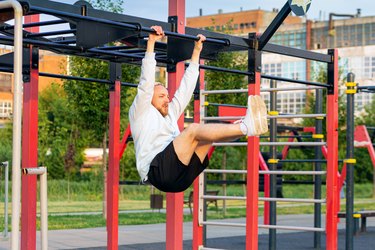
Rock hard abs don't come from sit-ups alone. You need to incorporate more intense ab exercises — such as hanging leg raises — to challenge your entire core. This exercise works your entire midsection, with particular emphasis on your hip flexors and the lower portion of your abdominals.
Related Reading
Video of the Day
How to Do a Hanging Leg Raise
- Hold onto a fixed pull-up bar with your arms and legs extended. Your feet should be off the floor.
- With your legs together, contract your abdominal muscles and lift your knees as high as possible by rolling up your spine and bringing your pubis toward your sternum.
- Slowly lower your legs back down.
Video of the Day
Tip
Hold a dumbbell between your feet to increase the difficulty of the exercise.
Muscles Worked During Hanging Leg Raises
The hanging leg raise requires flexion and extension of your torso. This activates the fronts of your hips, but also the "six-pack muscles" of your abs.
Iliopsoas
The iliopsoas is composed of two muscles — the iliacus and the psoas major. These muscles, also known as the hip flexors, are the prime movers for flexing the thigh and flexing the trunk. The iliopsoas is the primary muscle worked during a hanging leg raise.
Rectus Abdominis
The rectus abdominis are the most superficial of the abdomen — forming the enviable six-pack in lean athletes. The muscles flex and rotate the lower back and stabilize the pelvis during walking. The rectus abdominis muscles aren't engaged during a hanging leg raise until your knees rise above hip level and your pubis lifts toward your chest.
Obliques
The external and internal obliques are worked, to some extent, once your knees reach horizontal when performing a hanging leg raise. When the obliques work individually, they aid the muscles of the back in trunk rotation and lateral flexion — or bending side to side.
Tip
A variation of the hanging leg raise that puts more emphasis on your obliques has you alternately raise your legs to the left and right, rather than straight to the front.
Rectus Femoris
The rectus femoris is one of the four quadriceps muscles. It's the most superficial muscle in the middle of the front of the thigh. This muscle works with the iliopsoas to flex the hips during a leg raise. The rectus femoris also crosses the knee joint and assists the other quadriceps muscles in extending the knee.
Tensor Fascia Latae
The tensor fascia latae assists the iliopsoas and rectus femoris muscles during hip flexion. The muscle is located on the upper lateral thigh and is enclosed between layers of connective tissue known as fascia.
Related Reading
Adductors
The adductors are a group of muscles located on the inner thighs and consist of the adductor magnus, adductor longus and adductor brevis. These muscles along with the pectineus work to press the thighs together as you raise your legs.
Other Supporting Muscles
The muscles of your forearms, shoulders and back are used to grasp the bar, support your weight and stabilize your back and shoulder joints when you perform hanging leg raises.
Was this article helpful?
150 Characters Max
0/150
Thank you for sharing!
Thank you for your feedback!